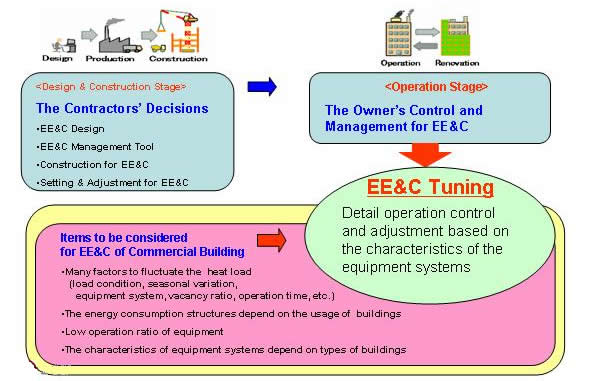Importance of EE&C Tuning for Buildings

| AEEC Home | Training Index | Index | Top | Previous | Next |
| METI / ECCJ / ACE Training Program MTPEC06 (2007.01) |
|
Counter measures for buildings
which ECCJ is disseminating. |
|
Importance of EE&C Tuning for Buildings |
 |
Examples of EE&C Tuning items for Buildings |
||||||||||
|
||||||||||
| Example 3: Energy-saving effect by reducing the outside air intake during air-conditioning ~Outline~ |
| Throughput heat energy of the outside air taken in during air-conditioning is unexpectedly large. About 20 kJ of heat energy is required to cool down and dehumidify 1 kg of outside air of 32oC dry-bulb and 60%RH to standard room climate conditions (28oC dry-bulb and 50%RH). In an office building, about 6 kg of outside air is usually introduced hourly per square meter of floor area, meaning that 120 kJ/h of treating heat energy is loaded on the air-conditioner, which is equivalent to 29% of the total load of air-conditioner (about 420 kJ/m2). Reviewing the number of persons working in the room, reduction of outside air intake should be made so that the CO2 concentration range should be within the one allowed by the Law for Maintenance of Sanitation in Buildings and you can make large saving of consumed energy by heat source equipment |
| Example 3: Saving energy by reducing the outside air intake during air-conditioning (1) |
|||||||||||||||||
| Building: High-rise office building in Tokyo, 40,000 m2. (Regional heat supply = Chilled water, 25 air-conditioners) Reduction of outside air intake during air conditioning within the range (CO2 concentration: 1,000 ppm or less) allowed by the Law for Maintenance of Sanitation in Buildings
|
| 6/10 Next |
| AEEC Home | Training Index | Index | Top | Previous | Next |